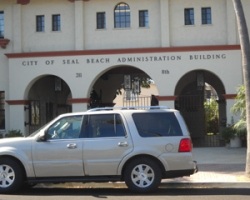The City Council unanimously approved the introduction of changes to the city’s parking laws and policies at the agency’s Monday, April 22, meeting. The ordinance updating the Municipal Code will return to the council for a second reading.
The council had considered changes to Seal Beach’s parking rules in late January, but the council directed staff to “redo” some of the proposed provisions—particularly the requirement that a car be relocated after the time limit on any particular street had expired.
One of the new rules in the ordinance that the council approved this week will require anyone who parks in a commercial area to move their car 150 feet to avoid a citation for parking over the time limit.
Parking consultant Julie Dixon said there would be no code regulating the movement of a car in residential areas. “Basically officer’s discretion,” Dixon said.
According to Dixon, the California Vehicle Code requires cars to be moved every 72 hours.
The commercial areas will be defined as “Main Street between Ocean Avenue and Pacific Coast Highway; Ocean Avenue between 8th Street and 10th Street; Central Avenue between 8th Street and 10th Street; and Electric Avenue between 8th Street and 10th Street and Pacific Coast Highway,” according to the staff report by Interim Police Chief Joe Miller.
“Vehicles that have not moved a minimum of 150 feet in commercial areas within 72 hours will be deemed stationary and may be removed,” according to Miller’s report.
Before Monday’s meeting, Councilwoman Schelly Sustarsic emailed staff to suggest the word “commercial” be added to page 3 of the staff report. Her questions and answers were available at the City Clerk’s table at the council meeting.
“Do we have residential ‘timed parking zones?’” Sustarsic asked.
The reply: “City streets with permit requirements are considered the time-restricted zones in the residential areas.”
The new rules also allow the establishment of taxi or rideshare pick up and drop off spots.
Sustarsic asked: How will the locations of the Taxi/Reideshare stops be determined? Will there be input from businesses and community in helping to determine these?”
Answer: “The Traffic Engineer has authority to determine locations for active passenger loading and unloading. Proposals for two loading/unloading locations—one on the west side of Ocean Ave across from Bogart’s Coffee and one in front of the Bay Theatre—have been submitted.”
While drafting the proposed code changes, Dixon said they had determined the city already had a section of the code to regulate service stations. Rather than write a new section of the code, the new rules update the service station rules to prohibit service stations from parking cars in residential neighborhoods.
The new code will also allow the city to issue temporary permits to individuals whose cars can’t be moved.
The new code “includes language that prohibits parking of oversize vehicles in lots to maximize parking availability,” according to Miller’s report.
The code also forbids the removal of chalk on tires. This is called “obstruction of enforcement.” It isn’t a new issue in town. In 2013, as reported in the Sun, Seal Beach Police received complaints that some Main Street merchants were erasing chalk marks from tires. At the time Sgt. Ron Lavelle (who has since retired) said, “That is a municipal code violation to remove the marker.”
In April 2013, Seal Beach Police issued an e-mail warning to merchants that erasing the chalk marks was against the city code.
This week, in an email, SBPD Commander Steve Bowles said, “We are using License Plate Readers as our primary enforcement tool and using chalk as a backup. If for some reason our technology has a snafu or is ‘down’ temporarily, we will use the traditional chalking method as a backup.”












